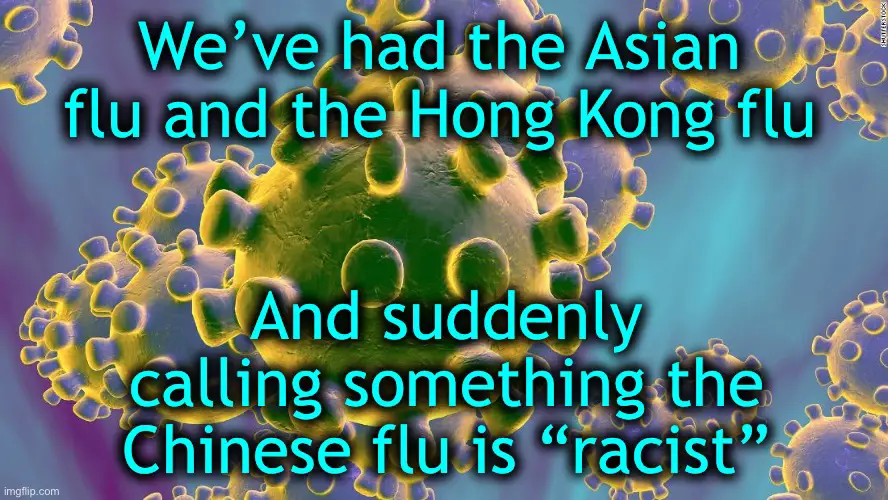This is a controversial topic, with potentially racial connotations, apparently, but are they justified? Media and politicians have got into ‘hot water’ this year for their names/remarks/statements of association of SARS-CoV-2 and COVID-19 with its country/city/culture/race of origin, an example of which is shown in Figure 1. Are these comments appropriate/suitable or are they racially derogatory? What I want to point out there are the origins of the names of some important viruses and the diseases they cause. A bit of historical context which shows similarities and differences over the last 130 years or so. This doesn’t necessarily make the current situation right or wrong, but I just wanted to put it into perspective with some historical context. Yes, times change and what was acceptable in the past may not be acceptable today. However, I did want to point out that the name “COVID-19” does seem inconsistent with historical naming of pandemic viruses and their diseases. When we consider the names of foodborne bacterial pathogens, the current viral naming convention seems even more out of place. However this is the 21st century and we are experiencing and unprecedented event, which may also apply to naming conventions.
Let’s start with some biology – viruses, by their very nature, are different from everything else in the biological world. They are considered in studies of biology, but it needs to be pointed out that viruses are not living organisms as they don’t satisfy the seven criteria of life (Figure 2). Unless they infect a host cell, they are simply an inert package of nucleic acid (DNA or RNA) surrounded by a protein coat. As they are not living organisms, their nomenclature is also very different. Taxonomists have attempted to place them in a hierarchal taxonomic scheme, but due to their fundamental differences with all living things, it isn’t the same. Thus, their names tend to be rather informal, especially when compared to the strict naming conventions of living things; animals, plants, bacteria, fungi and others.
What prompted this blog post was a petition I signed late in January regarding what I (and tens of thousands of others) considered at the time to be a rather racist reference on the front page of the Herald Sun, a Melbourne newspaper (Figure 3). However now, I wondering if it was really that bad. Let’s explore.
The front page of the Herald Sun on that day referred to the nCoV-2019 (as it was still known at the time) as the “Chinese Virus”. There was an uproar over this racially orientated headline and the newspaper forced to apologise. However, when one looks back over the names of other viruses and the diseases they’ve caused, the name seemed quite fitting. SARS-CoV-2 (as it is known now) originated in China and in Wuhan specifically. Therefore, calling the virus the “Chinese Virus” and maybe calling the disease “Wuhan pneumonia” rather than COVID-19 is more meaningful. This is especially when one considers other viral (influenza) pandemics last century and late in the 19th century. The 1889-1890 influenza pandemic that originated in Bukhara, Uzbekistan (which then was a semi-independent state under Russian protection) is known as Russian flu; the 1918-1919 influenza pandemic is known as Spanish flu (Figure 4) because the Spanish, not subject to wartime media censorship, reported more details of the sickness, death and suffering more than anywhere else in the world; the 1957-1958 influenza pandemic which originated in China’s Guizhou province is known as Asian flu (Figure 5); while the 1968 influenza pandemic which originated in Hong Kong is known as Hong Kong flu (Figure 6). Furthermore, the H5N1 influenza outbreak of 2004 which originated in Thailand and Vietnam is commonly known as avian or bird flu, while the H1N1 influenza pandemic of 2009 which originated in Mexico is known as swine flu… …and how about the last Coronavirus outbreak? That started in 2012 and caused by MERS-CoV, with the disease called Middle Eastern Respiratory Syndrome. This is the official name given to the disease by the WHO. Why? …because the disease originated in the Middle East. With all this in mind, we’re calling the disease of the current Coronavirus pandemic COVID-19? That really seems out of place while Chinese or Wuhan pneumonia seems more appropriate. Ok, so that’s some history of names of viral diseases and the viruses that cause them. Let’s turn our attention to bacteria, especially foodborne disease pathogens.
As a point of comparison, some of the biggest names in foodborne bacterial pathogens, some of which are zoonotic, are Salmonella, Escherichia (especially E. coli) and Listeria, all of which are named after people, as were Shigella and Yersinia. These bacteria were usually named after the scientists who discovered them.
Escherichia named after Theodor Escherich from Germany (Figure 7).
Listeria named after Joseph Lister from England.
Salmonella named after Daniel Elmer Salmon from the United States (Figure 8).
Shigella named after Kiyoshi Shiga from Japan.
Yersinia named after Alexandre Emile Jean Yersin from Switzerland.
Especially with bacterial names, it is a great honour and privilege to have a bacterium named after you, yet China and Wuhan consider it a dishonour. We call H1N1 swine flu and H5N1 bird flu – do we consider if this is a dishonour to pigs and birds? So, from this we can see that microbial names and/or the diseases they cause have typically reflected some key and/or specific aspect of their origin, but COVID-19? it really doesn’t seem to match, especially based on historical naming conventions, but is now considered racially derogatory (Figure 9) …unless the World Health Organization or others are breaking with tradition and starting a new nomenclature convention?
This actually does seem to be the case, to some extent. The reader is referred to a comprehensive paper written by the Coronaviridae Study Group of the International Committee on Taxonomy of Viruses on virus and specifically Coronavirus nomenclature and taxonomy (Gorbalenya et al., 2020). It was published online in Nature Microbiology on 2 March 2020 The details presented highlight the highly scientific based approach to viral taxonomy, even though the names settled on for viruses may not always seem particularly scientific. In particular, I draw attention to this extract from their paper: “Apart from disease, geography and the organism from which a given virus was isolated also dominate the nomenclature, occasionally engraving connections that may be accidental (rather than typical) or even stigmatising, which should be avoided”. There seems to be some errors in wording of this sentence, but you get the gist. From this one can see that scientists are working hard to bring formal naming rules into practice (that fit into taxonomic hierarchy) which accurately reflect the disease and entity causing disease, while ensuring the names avoid stigmatising cultures, groups or countries. So yes, times change, people change, everything changes. These improved naming conventions have changed the way pandemics and their viruses are named. Therefore, COVID-19 is an accurate way to scientifically represent this disease by name, rather than “Wuhan pneumonia”, which is not appropriate in many ways, not even in casual/informal conversation.
Reference
Gorbalenya, A.E., Baker, S.C., Baric, R.S. et al. The species Severe acute respiratory syndrome-related coronavirus: classifying 2019-nCoV and naming it SARS-CoV-2. Nat Microbiol 5, 536–544 (2020). https://doi.org/10.1038/s41564-020-0695-z













Very well written. Really enjoy reading it and love all those Figures. Good one!